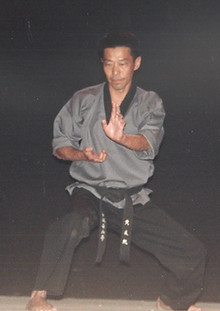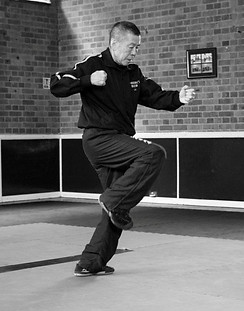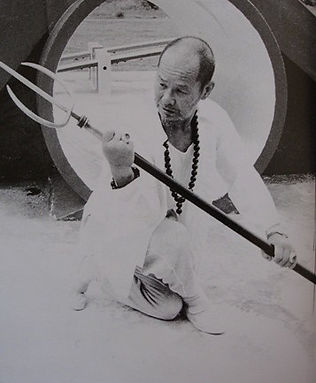Introduction
Our style embodies a very broad perspective of techniques; from basic punching, kicking, locking & takedowns, nerve points used in combination with each other.
We believe that a firm grounding in all the basics is very important to enable better development for the future. Hence all participants from the juniors to the most senior should not forget the basics. Within our system are unique styles which form up the more specialised elements.
We teach a number of traditional weapon forms within the system. Other specialised forms include animal styles which are a part of traditional chinese kung fu - Monkey, Leopard, Tiger, Eagle, Snake are but some of the many styles we teach. Aside from the physical manifestation breathing exercises are also very important, also known as Chi-Gung, it helps internal conditioning through the control of the body's chi.
Teaching Philosophy
As a martial arts school we teach students to behave with the upmost sincere and well behaved manner. Disrespect is not tolerated and we instil this in all our teaching from the youngest to the most senior student.
Whilst being traditional we recognise the need to adapt to modern day practical applications. In this we assess and adapt our teaching to suit different situations and for different physical form.
Development and Progess
Grading examination takes place every quarter of the year with the set months being in March, June, September & December.
Whilst the journey is different for everyone, we do not expect students to be participating in exams every 3 months. Everyone will move at their own speed and we as a system never push for students to be rushing through to jump from one grade to another.
For us it's more important that student fully grasp the knowledge and meaning behind what we teach before attempting to move onto the next level.
Historical Origins
Our origins lie in the shaolin style known as Fat Gar Kuen, as taught in Malaysia, Singapore and Indonesia. The historical roots of the style lie in the monastery shaolin tradition in the Southern Fukien province of China. The best known Grandmaster of this style was the Abbot Seh-Koh-San who was until his death in 1960 the chief abbot of the shaolin Siong Lim Temple in Singapore.
Our Official Connection
We are a member of the British Council for Chinese Martial Arts (BCCMA), the controlling body or the Chinese Martial Arts in the U.K. The system has been taught in the U.K since 1979.





Our Lineage
The Shaolin style Gao Can Mun Nam Pai Chuan has its roots and origins in the traditional martial arts practiced by the Shaolin Monks of China over 2000 years ago.
Though much of martial arts history could be told in the form of legends and stories of martial arts heroes, it is widely accepted that Shaolin Kung Fu was brought to China and Japan/Korea in the year 525AD by a travelling Buddhist monk known to the Chinese as ‘Da-Moh’ (Bodhidharma). He is credited with having taught kung fu to the monks in order to strengthen them for meditation and prayer. It is hard to believe that war-like nations like the Chinese, Japanese and Koreans did not possess a martial arts skill of their own.
The truth is probably that Da-Moh consolidated these skills and had the organisational ability to advocate it to his students. Through the years, the art has grown and developed into many diverse forms and schools but regardless of the style, they could all be traced back to Da-Moh.
The Gao Can Mun Nam Pai Chuan tradition or style can trace its lineage far back to Great Grandmaster Hui Cheng of the Chek Chian Nan Hai Pooi Chee Temple in China. Master Hui was a direct descendant of the Southern Shaolin tradition taught by Buddhist monks in the tradition of Da-Mo.
One of Master Hui Cheng’s students was Grand Master Seh Koh San, A famous Shaolin Monk attributed to be the father of traditional Shaolin Arts in South East Asia. Shi Gao Can (1886 – 1960) or widely known as Sek Koh Sam, was a Chinese monk who brought traditional Shaolin teachings from Mainland China to South East Asia.
Master Quek Heng Choon is considered to be Shi Gao Can’s most important and influential student from the Singapore/Malaysia era. Born in 1926 in Huian county, Fujian province, China, Master Quek represents the original 50th generation of Shaolin and taught students from Malaysia, Singapore, and China between 1956 and 2010.
During a training visit to London in 2009 Master Quek named Christopher Lai Khee Choong who is head of Nam Pai Chuan worldwide as his successor and asked that the school be renamed as “Shaolin Gao Can Mun Nam Pai Chuan”.
Master Lai lives in London and continues to teach the Shaolin System to this day.



Seh Koh San 高參法師
Abbot and Ancestor of the system (祖先)
Cho-Si (Ancestral Master) Seh Koh San was a Shaolin monk who lived from 1886 to 1960 and is widely recognised as being the father of traditional Shaolin Arts in South-East Asia. He came from the Hailou Village, in the Fujian Province and brought traditional Shaolin teachings from mainland China to South-East Asia. At the age of 13, Seh Koh San left home to join a security guard who protected goods on the road. His name was “Cho Pew” and he was the first person to teach Seh Koh San Kung Fu. It was with Cho Pew that Seh Koh San learned the Five Ancestors Fist (Fifth Generation Fist), another famous style developed from Shaolin. Cho Pew had five students and called Seh Koh San – his most promising student – ‘Lim Tian Pau’ or the ‘Flying Leopard’.
For three years, he studied martial arts with Cho Pew and became an outstanding student who mastered the Hing Kung (High Leaps) and the use of different types of Ying Ju (hidden weapons). In 1903, aged 18, he was taken in by the chief monk Hung Leong (Hui Ching) as a disciple. He had his hair shaved at the Wai Onn Ching Hing (Hui Ann Cheng Yim) Temple. He went on to study Buddhist scripture at the Fu Tin Mui Fung Temple from the chief abbot Mei Kar and senior monk Hung Leong and was to become one of the most outstanding monks of his Cha’an generation.
His teacher, the chief abbot Wei Jing, lived at Poh Jai Temple in Jit Xiang (River) Nam Hai and was the Shaolin 48th generation, and Poi Jai Temple 6th generation of the second discipline. He had just three students and only Seh Koh San fully mastered the art of Shaolin Kung Fu. Because of this, Seh Koh San became the only monk to carry on the 48th generation martial arts in South-East Asia. This Shaolin Kung Fu has been referred to as Hood Khar Pai, Fat Gar, Lohan or Nan Pai.
Seh Koh San continued to train in the martial arts in the South Shaolin tradition until 1919. He was the only ‘inner circle’ disciple of his master and took a sacred oath never to disclose the art to the outside world. Besides Buddhism and the martial arts, he was also taught traditional Chinese medicine and acupuncture and he tried to eliminate disease and relieve pain whenever and as widely as he could. In 1926, Poh Jai Temple started travelling throughout South-East Asia to practise healing wherever he could, and visited Thailand, Burma, Malaysia, Singapore and Indonesia. In every place he visited he treated the sick and spread Buddhism, for which he would eventually gain his greatest fame. He stayed in Indonesia, then occupied by the Dutch and called Royal Dutch Indies, for 21 years and became the abbot of the Zhen Yuan Gong temple in Medan the capital city of North Sumatra province, Indonesia.
As part of his work healing the sick he started to realise that learning martial arts could help strengthen his patients and improve their physical condition. At 56 years old, he sent a letter to his master, the chief abbot Wei Jing, asking him for permission to teach. Wei Jing’s brother in Dharma replied to him and informed him that Shi (monk) Wei Jing had passed away. He granted Seh Koh San permission to teach his brother’s martial art and encouraged him to train his successors – the 49th generation.
Before Seh Koh San began teaching any new student martial arts, he ensured they vowed before Buddha that they would never use the skill for any impure motive. From then on he started spreading his teachings all over South-East Asia. The style became famous under the name of Buddhist Boxing. In 1948, after the Second World War, Seh Koh San travelled to Singapore to the Shuang Lin Temple where, for six years he was made the director abbot. On May 6th, 1954, he was inaugurated as abbot of the temple to the sound of thousands of monks shouting for joy, firecrackers banging and music. He served as the abbot of Shuang Lin for 13 years.
On May the 16th 1960 Shi Gao Can passed away, aged 74.
His mortal remains were placed in the temple for a period of seven days for his students, disciples and Buddhist monks to pay their last respects. His funeral took place on May 22nd 1960 on the Kong Meng San Phor Kark See Monastery and was attended by more than 7,000 mourners.



Quek Hen Choon 郭逢春
Great Grandmaster (太師公)
Quek Heng Choon was born in 1926 in Huian county in the Fujian province of China. At the age of 13, he met a wandering medicine seller named Liu Pingshan who was a master of the Taizu style and became his student for three years.
In 1942, aged 16, his uncle asked him to join the army. He refused and left home to live in the Quanzhou Kaiyuan Temple. There, he studied martial arts under Monk Maoyue for 15 months learning Wuzu Quan Sanzhan Simen Quan 18 step Saozhuan Quan.
After this period he left the temple but realised that if he returned home, he would again be asked to join the army so he went to Xiamen to work in a teahouse before eventually deciding to move to Singapore to live with his aunt. In 1947 Quek Heng Choon went to Singapore aged 21 where he heard that it was possible to study martial arts in the Singapore Shuang Lin Temple where Seh Koh San was abbot at the time. He was eventually accepted as a student.
Seh Koh San was very strict with his students and insisted they remained inside the temple walls to study martial arts for at least three years, during which time they weren’t allowed to step outside the temple gates. Training took place three times a day, at five in the morning, at midday, and at seven in the evening, every single day.
After seven years of dedicated training Seh Koh San informed Quek Heng Choon that his study of the arts had been successful, and that he could now ‘come down from the mountain’ (leave the temple).
In 1954, he left the temple with a classmate and together they started the Singapore Sao Hua San Athletic Association.
In 1956 he left for Penang where he founded the Penang Sao Lim Athletic Association for Seh Koh San. He spent two years setting up the school and finding new students for his teacher – at one time there were more than 300 people studying there. The school is now run by Master P’ng Chye Khim.
In 1958 he founded another school, Penang Sao Wah San Athletic Association, and later, taught at another school in Penang. The following year he went to Kuala Lumpur to work in the harbour and teach martial arts in a new village near the harbour, three times a day.
On May 16th 1960 his teacher Seh Koh San passed away. At this point Quek Heng Choon started to teach students on his own in order to popularise the martial arts. In 1963 he was asked to become the chief instructor of a school in Kuala Lumpur and became famous for demonstrating Ying Qigong (hard chi gung[e3] ) by breaking marble table tops on his back and with his hand. He even received praise from the prime minister of Singapore, Lee Kuan Yew (Li Guangyao).
In 1971 he started his first formal school, Quek Heng Choon Martial Arts Sport School, which attracted students from both Singapore and Malaysia. The next year he was to be the permanent chief instructor of Penang Shao Ci Shan Athletic Association.
He represents the original 50th generation of Shaolin.
In 1973 his students joined the first South-East Asia Competition and were very successful. He was made an advisor and judge for the competition. In the same year, a Hollywood movie company shot the movie ‘Paper Tiger’ in Malaysia and asked Master Quek to create some of the fight scenes along with Master Leow and Master Lai. Some of his students also acted in the movie.
In 1974 he went back to China to visit his family and also visited the Quanzhou Kaiyuan Temple, where he had studied martial arts 30 years before.
In 1977 he initiated the Kuala Lumpur Song Shan Shaolin Wushu Association and became a permanent chief instructor of the school.
In 1990 he started the Shaolin Gao Can Mun in Singapore of Heroufo State and became the chief instructor.
In 1993 he went back to China (Fujian Quanzhou) and started a school to teach Shaolin Wushu and Yijining.
In 1998, he returned to Malaysia to teach his students again, which he did until his demise. He taught Yangshen Shu, long and short weapons, Yijinjing, Luohan Yangshen gong, Shenxinfa, Quantao: Yizhimei, Yizhichun and much more.
Master Quek is considered to be Shi Gao Can’s most important and influential student from the Singapore/Malaysia era.
During a training visit to London in 2009 Master Quek named Christopher Lai Khee Choong, who is head of Nam Pai Chuan worldwide, as his successor and asked that the school be renamed as “Shaolin Gao Can Mun Nam Pai Chuan”.
Unfortunately during a visit to China in February 2010 Master Quek succumbed to illness and passed away. He was aged 85.
Sifu Lai and his students worldwide will continue to teach the art that was passed to them from him.



Lai Khee Choong
Chief Instructor (師公)
Master Lai, 2nd chamber 50th generation of Shaolin has studied martial arts since 1959 and in particular Shaolin Kung Fu from 1967. His daily training was intense, and undertaken in the traditional manner.
In addition to Shaolin Kung Fu, Master Lai also trained, in the 1970s with Master Leow Cheng Koon, who was Chief Instructor of the MTA (Malaysian Taekwondo Association), member of the Taekwondo Federation (WTF).
Master Lai decided to emigrate to United Kingdom (UK), where he had undertaken his legal education and since martial arts was part of his life, he felt the need to bring his school with him.
Prior to his departure, Grandmaster Quek gave his permission for Master Lai to teach the Shaolin system Nam Pai Chuan when he came to the UK, bringing it to Europe for the first time.
Master Lai began teaching Shaolin Nam Pai Chuan in Swiss Cottage, London and established it as a member organisation of the British Council for Chinese Martial Arts (BCCMA), the national governing body for Chinese martial arts in the UK. Shaolin Nam Pai Chuan has grown ever since with new training centres being established across the globe and teaching in the same sincere and dedicated manner as Master Lai and his predecessors.
On July 20th 2009, Grandmaster Quek made Master Lai his system successor. In honour of his teacher’s request, Master Lai renamed his school ‘Shaolin Gao Can Mun Nam Pai Chuan’.
